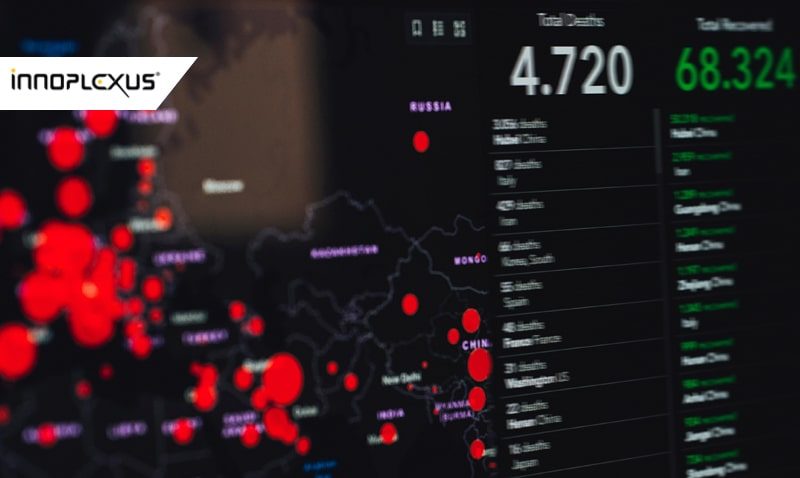
Ontosight® – Biweekly NewsletterJune 17th – June 30th, 2024 –Read More

Ontosight® – Biweekly NewsletterJune 17th – June 30th, 2024 –Read More
May 24
Apr 24

Innoplexus wins Horizon Interactive Gold Award for Curia App
Read More
Traditionally, surgeons-in-training have been instructed to “see one, do one, teach one”.1 Echoed in David Kolb’s experiential learning theory, this teaching method capitalizes on a holistic, multi-linear model of adult development and skill mastery that declares experience to be the keystone of the learning process.2
When it comes to outbreaks of infectious disease, the world should capitalize on the lessons of other nations. We are now experiencing first-hand, a global pandemic, and will benefit by turning to the experiences of those countries who have implemented robust strategies of early testing, social distancing, and containment.
As the first large-scale public health threat of the decade, COVID-19 emerged quietly from the Huanan Seafood Wholesale Market in Wuhan, China in the form of unusual pneumonia.3 Its genome was decoded at a laboratory in Shanghai on January 11, 2020,4 but evaded the public eye due to the failure of the China Infectious Disease Automated-Alert and Response System, which – as the largest disease surveillance network with a web-based reporting system in the world – was developed in response to the 2003 SARS outbreak and founded upon a very bureaucratic, three-level upward-flow of signal generation, dissemination and response.5
Dr. Zhong Nanshan, the luminary who discovered the SARS coronavirus in 2003, did not arrive in Wuhan until January 18.6_7 By then, COVID-19 had already caused one death in China and was confirmed in one patient in France and another in Thailand.8 Zhong realized that with the record spread of the virus, containment could only be achieved by drastic measures. At his behest, Wuhan was locked down on January 23.9
Yet internationally, no such measures as applied in Wuhan were taken. With a median incubation period of approximately 5 days and an asymptomatic manifestation,10 COVID-19 spread quietly as its hosts traversed the globe. By the end of January, the virus had found its way to the U.S.11 By mid-March, over 2,000 reported cases existed within the country.12
In the past, the U.S. has been fortunate to avoid the experience of Asian countries and their encounters with coronaviruses such as SARS and MERS. As such, there has been a degree of naivete to learn from Asia’s management of such outbreaks – until now.
Following the declaration of COVID-19 as a public health emergency at the end of January, international governments are escalating their responses to the rapidly evolving situation. But despite the bevy of emergency powers unleashed by public health and disaster management authorities, the issue has been hampered by insufficient early testing and delayed containment.13 Dr. Bruce Aylward, a senior advisor to the director-general of the WHO, attributes these to a “completely different willingness to properly prepare” when compared with other countries – particularly those in Asia whose health systems have experienced epidemics before and have evolved to reflect the lessons learned.
Thus, in managing the COVID-19 response and mitigating the major threat to public health, government officials can learn from the bold action taken by governments that have “seen one, done one” in the past. However, it is important to remember that as the U.S. receives instruction from the lessons learned by other countries, it should also stand ready to learn from its own citizens.
The quarantine of the 11 million citizens of Wuhan, China was one of the first signals of COVID-19’s high transmissibility. While the extent of the Wuhan lockdown was unprecedented, its enforcement of the quarantine was reminiscent of China’s community-wide containment measures implemented during the 2003 SARS outbreak.14_15 In addition to declaring epidemic zones and designating entire villages, cities, and institutions for collective quarantine, the Chinese government also closed all universities and public spaces.16
Though criticized for restricting information sharing and lack of timely response, China ultimately corralled the political commitment of its people and their willingness to prepare, provided central guidance for the nation, and gained control of all activities to combat SARS, resulting in a central response that immediately and significantly decreased the disease’s R0.17
The lockdown of Wuhan has yielded a similar outcome for COVID-19. Infection rates have now plunged to their lowest since the start of the pandemic, enabling several makeshift hospitals to close and prompting some schools to reopen.18 Despite initial doubts about the effectiveness of the method, the WHO has commended China for its success and “commitment from top leadership, and the transparency they have demonstrated.”19 Epidemiologists around the world have similarly touted the “China model” as a key to containing COVID-19, with the leader of the WHO mission to China stating that “hundreds of thousands of people in China didn’t get COVID-19 because of their aggressive response.”20

Compared to this, Singapore’s approach to the 2003 SARS outbreak was vastly different, focusing instead on early containment and increased public awareness. The government believed that with greater knowledge of SARS, citizens would be motivated by higher levels of anxiety and greater risk perceptions to take comprehensive precautionary measures against the infection, thus inhibiting its spread.21 In combination with mandatory temperature monitoring and public service announcements, Singapore was also able to both increase case detection and detect the disease at an earlier stage.22
The 2003 SARS epidemic initiated massive revisions to the health infrastructure in Singapore, whose government decided to invest for the future and revamp the public health system in an effort to reduce the social and economic costs that would be incurred should another epidemic arise. As such, Singapore’s response to COVID-19 – a more transmissible virus than SARS – was more aggressive than the health control measures implemented in 2003. As one of the first countries to impose restrictions on recent travelers to China and South Korea, Singapore also tightened controls over immigration policies, against the recommendations of the WHO. Also one of the first countries to develop its own test for COVID-19 following publication of the virus’ genetic sequence, Singapore ramped up production of materials necessary for the test and adjusted its national financial system to ensure that all healthcare related to the disease would be free.23 Stringent quarantine protocols for potentially infected patients were cemented in place with the goal of identifying and treating each case as it arose.24

This success in Singapore did not come without a cost. Notably, the Singaporean government publicly denounced any deviation from containment procedures, warning that the nation would “not hesitate to take strong action …[and] swift and decisive response” against rule-breakers.25_26 In spite of this, Singaporeans still demonstrated strong political will to enforce all public health measures as well as an extremely high willingness to be quarantined if necessary.27 As evidenced by a slowing rate of COVID-19 infection and increasing rate of recovery, Singapore has successfully flattened the curve and demonstrated that it is possible to contain, if not neutralize, the threat.28

Much has been written on the lessons to be learned from Asian countries such as Singapore and China.29 The U.S. is learning from their efforts at the federal level, President Trump recently announced a public-private partnership to increase detection measures and, in officially declaring a state of national emergency, unlocked access to emergency funds and allowed for waiver of certain restrictions on medical practice,30 and at the level of local government, many cities and states have suggested a temporary ban on mass gatherings.31_32 Yet some of the measures implemented in Asian countries – stringent quarantine procedures and clear and accurate communication – have yet to be implemented uniformly across the U.S.
There are several reasons for this. Firstly, the sheer size of the nation presents geographic challenges unlike those seen in jurisdictions such as Singapore. U.S. law does not currently support mandates of its citizens similar to those provided for in Asian countries The unique geographic and cultural overlay of the U.S. may dampen the effectiveness of containment procedures implemented by local or federal government.
Federal quarantine and isolation powers within the country are limited and have not been used liberally.33 Day-to-day prevention tactics such as wearing face masks or mandatory temperature monitoring in an office building34 are not within the cultural norm. Local governments within the U.S. have been emulating some tactics from nations such as South Korea – drive-through testing, for instance – without much disruption to American habits.35
This is also observed on a more macro level. For instance, private U.S. industry has taken its own action. Movie theaters have begun implementing attendance limits.36 Google has made its premium video chat suite available to allow businesses and schools to maintain social interaction notwithstanding social distancing policies.37 Other tech companies have banded together to aid workers who cannot afford sick leave, do not have health insurance, or to support healthcare workers.38
Global communities are adapting to a “new normal”.39 Within the vast geographical and cultural diaspora of the U.S., positive change will certainly emerge. The U.S. will successfully weather this crisis as it identifies outliers, understand the community-driven solutions they come up with, and replicate those success stories nationwide.
The lessons learned by looking abroad at Singapore and China – along with other Asian countries – will be instructive for the United States, Europe, or other geographies that are further out on the timeline of pandemic progression. These countries share the characteristic of using their experiences with prior epidemics to build, rebuild, and strengthen their health systems and thus their lessons offer a model for what to do next, supported by real world evidence on how to respond to the pandemic with fewer deaths. Though Singapore and China were better prepared for COVID-19 because their countermeasures were already established and ready to be activated, recovery and flattening the curve globally. is still feasible. Countries will learn from this experience of others and find ways to apply that learning domestically. And as the U.S. applies best practices and lessons learned from foreign countries’ handling of the coronavirus, it will also have plenty to teach itself.
References:1. https://www.ncbi.nlm.nih.gov/pmc/articles/PMC4785880/
2. https://www.simplypsychology.org/learning-kolb.html
3. https://www.aljazeera.com/indepth/interactive/2020/03/covid-19-charts-maps-200310163714493.html
4. https://www.scmp.com/news/china/society/article/3052966/chinese-laboratory-first-shared-coronavirus-genome-world-ordered
5. https://www.ncbi.nlm.nih.gov/pmc/articles/PMC5423001/
6. https://www.vox.com/2020/2/4/21122072/china-coronavirus-healthcare
7. http://jtd.amegroups.com/about/editorInChief
8. https://www.reuters.com/article/us-china-health-sars/the-shadow-of-sars-china-learned-the-hard-way-how-to-handle-an-epidemic-idUSKBN1ZL12B9. https://www.reuters.com/article/us-china-health-who-idUSKBN1ZM1G9
10. https://annals.org/aim/fullarticle/2762808/incubation-period-coronavirus-disease-2019-covid-19-from-publicly-reported
11. https://www.cdc.gov/media/releases/2020/p0130-coronavirus-spread.html
12. https://www.nytimes.com/interactive/2020/us/coronavirus-us-cases.html
13. https://www.wired.com/story/what-government-emergency-declarations-can-and-cant-do-in-a-pandemic/
14. https://www.reuters.com/article/us-china-health-who-idUSKBN1ZM1G9
15. https://onlinelibrary.wiley.com/doi/pdf/10.1111/j.1365-3156.2009.02348.x16. https://onlinelibrary.wiley.com/doi/pdf/10.1111/j.1365-3156.2008.02146.x
17. https://onlinelibrary.wiley.com/doi/pdf/10.1111/j.1365-3156.2009.02348.x
18. https://www.straitstimes.com/asia/east-asia/mainland-china-reports-40-new-cases-of-coronavirus-lowest-since-january
19. https://www.cnn.com/2020/02/14/asia/coronavirus-who-china-intl-hnk/index.html
20. https://www.nytimes.com/2020/03/04/health/coronavirus-china-aylward.html/21. https://core.ac.uk/download/pdf/37890064.pdf
22. https://adc.bmj.com/content/archdischild/89/8/739.full.pdf
23. https://www.npr.org/sections/goatsandsoda/2020/03/12/814522489/singapore-wins-praise-for-its-covid-19-strategy-the-u-s-does-not
24. https://www.wired.com/story/singapore-was-ready-for-covid-19-other-countries-take-note/#intcid=recommendations_wired-right-rail-popular_24b86252-f740-4cce-9863-99d4759816eb_popular4-125. https://www.iatatravelcentre.com/international-travel-document-news/1580226297.htm
26. https://fortune.com/2020/02/28/singapore-coronavirus-contained-response/
27. https://core.ac.uk/download/pdf/37890064.pdf
28. https://www.npr.org/sections/goatsandsoda/2020/03/12/814522489/singapore-wins-praise-for-its-covid-19-strategy-the-u-s-does-not29. https://time.com/5802293/coronavirus-covid19-singapore-hong-kong-taiwan/
30. https://www.cnn.com/2020/03/13/politics/donald-trump-emergency/index.html
31. https://www.nytimes.com/2020/03/12/nyregion/coronavirus-nyc-event-ban.html/
32. https://www.gov.ca.gov/2020/03/11/california-public-health-experts-mass-gatherings-should-be-postponed-or-canceled-statewide-to-slow-the-spread-of-covid-19/33. https://www.wired.com/story/what-government-emergency-declarations-can-and-cant-do-in-a-pandemic/
34. https://www.straitstimes.com/singapore/coronavirus-long-queues-formed-at-suntec-city-and-raffles-place-on-first-day-of
35. https://www.hawaiinewsnow.com/2020/03/12/urgent-care-facilities-now-offering-drive-through-coronavirus-testing/
36. https://www.cnbc.com/2020/03/13/coronavirus-amc-puts-capacity-cap-on-theaters.html
37. https://cloud.google.com/blog/products/g-suite/helping-businesses-and-schools-stay-connected-in-response-to-coronavirus
38. https://www.geekwire.com/2020/microsoft-amazon-others-form-2-5m-coronavirus-response-fund/
39. https://www.theatlantic.com/ideas/archive/2020/03/you-will-adjust-new-normal/607873/
The cost of developing a new drug roughly doubles every nine years (inflation-adjusted) aka Eroom’s law. As the volume of data…
There was a time when science depended on manual efforts by scientists and researchers. Then, came an avalanche of data…
Collaboration with key opinion leaders and influencers becomes crucial at various stages of the drug development chain. When a pharmaceutical…
Data are not the new gold – but the ability to put them together in a relevant and analyzable way…
Artificial intelligence, or AI, is gaining more attention in the pharma space these days. At one time evoking images from…
Artificial intelligence (AI) is transforming the pharmaceutical industry with extraordinary innovations that are automating processes at every stage of drug…
There is a lot of buzz these days about how artificial intelligence (AI) is going to disrupt the pharmaceutical industry….
Drug discovery plays a key role in the pharma and biotech industries. Discovering unmet needs, pinpointing the target, identifying the…
The pharmaceutical industry spends billions on R&D each year. Clinical trials require tremendous amounts of effort, from identifying sites and…
Training algorithms to identify and extract Life Sciences-specific data The English dictionary is full of words and definitions that can be…
The early 1970s introduced the world to the idea of computer vision, a promising technology automating tasks that would otherwise…
Summary: AI could potentially speed drug discovery and save time in rejecting treatments that are unlikely to yield worthwhile resultsAI has…